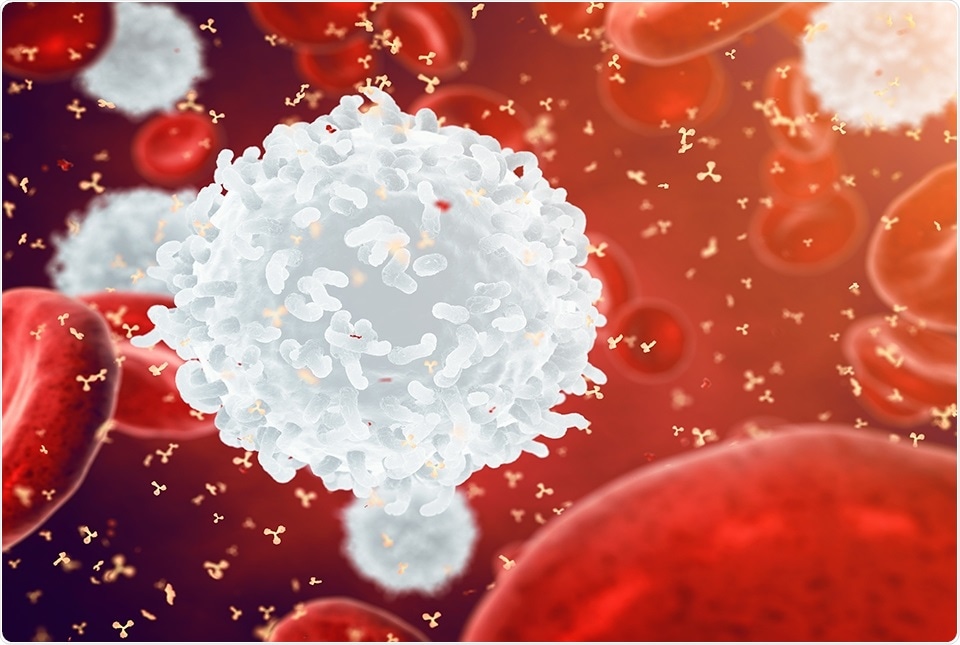Scientists from Weill Cornell Medicine recently found the master regulator behind the development of antibody-creating cells. The observations offer novel insights into the inner workings of the immune system and might help achieve a thorough knowledge of the development of tissues and the emergence of certain cancers.

Illustration of B cells, antibodies, and red blood cells. Image Credit: Shutterstock.
The research combined computational analyses with advanced molecular biology and genomic techniques to pinpoint a protein named OCT2 as the major determinant of the B-cell humoral immune response. The research was published on September 23rd, 2021, in the Nature Immunology journal.
After vaccination or during an infection, mature B cells form germinal centers, a kind of pop-up training facility. The cells mutate and rearrange their antibody-encoding genes there, till they either produce an enhanced antibody or die trying. The mechanism is fundamental to the body’s responses to various pathogens; however, it is also filled with danger as poorly-placed B cell mutations can result in lymphoid cancers.
All of our cells have defense mechanisms against becoming mutated, but B cells actually do the opposite; they specialize in mutating, and they do it very fast.”
Dr Ari Melnick, Study Co-Senior Author, Gebroe Family Professor, Hematology/Oncology, Division of Hematology and Clinical Oncology, Weill Cornell Medicine
Dr. Ari Melnick is a member of the Sandra and Edward Meyer Cancer Center at Weill Cornell Medicine.
Earlier studies revealed that B cells regulate their germinal center maturation by modifying the accessibility of various parts of their genomes and inducing cascades of gene expression changes to direct and restrict their development. It is yet unknown what coordinates all of those signals.
To find a solution to the question posed, Weill Cornell Graduate School of Medical Sciences student Ashley Doane, and co-workers from Weill Cornell Medicine and Rockefeller University, undertook a computational approach, mapping all the gene regulation changes maturing B cells endure.
We started off creating an atlas of all the regulatory elements that come into being and disappear over that period of time.”
Dr Ari Melnick, Study Co-Senior Author, Gebroe Family Professor, Hematology/Oncology, Division of Hematology and Clinical Oncology, Weill Cornell Medicine
By creating novel computational methods, the researchers were able to deconvolute the changes to pinpoint OCT2 as the molecule that seemed to be at the root of the mechanism.
However, the dispersion of OCT2 in germinal centers was astonishingly similar to its distribution in mature B-cells before their activation.
The scientists probed B cells with novel molecular and genomic tools in the laboratory and discovered that OCT2 in immature B cells pre-positioned in the genome locations where it will later operate at the time of germinal center reaction. Another gene regulatory protein, OCA-B, induces the genome locations marked by OCT2 to become active, changing them into “super-enhancers” that propel the rest of the B cell maturation regulatory network.
“The destiny of the cell is predetermined in a way so that if it gets the right signal, it will know how to create the germinal center B cell,” adds Dr. Melnick.
The concept of cellular predestination—and the recognition of a distinct process for it—might be the study’s most comprehensive finding.
I think that’s potentially a profound finding that could apply to many different transitions between cell types.”
Dr Olivier Elemento, Study Co-Senior Author and Director, Caryl and Israel Englander Institute for Precision Medicine, Weill Cornell Medicine
Dr. Olivier Elemento is also the associate director of the HRH Prince Alwaleed Bin Talal Bin Abdulaziz Alsaud Institute for Computational Biomedicine at Weill Cornell Medicine.
At the time of embryonic development, for instance, a single cell divides and matures into all cells of a whole organism, as a result of a series of branching decision points that could employ similar processes to mark super-enhancers for later activation.
A powerful and novel means to combat cancer can be availed by targeting master regulators like OCT2 and OCA-B, or their counterparts in other types of cells.
“Very often what you’ll see is if a gene is really important in terms of maintaining the cancer state, that gene will tend to be regulated by a super-enhancer. Cancer cells rely on them as a way to maintain their identity,” states Dr. Elemento, who is also a professor of physiology and biophysics and professor of computational genomics in computational biomedicine at Weill Cornell Medicine.
Interrupting the ability of the tumor cells to develop critical cell-type, specific super-enhancers can efficiently pull the rug out from under them, arresting their whole survival plans.
Source:
Journal reference:
Doane, A. S., et al. (2021) OCT2 pre-positioning facilitates cell fate transition and chromatin architecture changes in humoral immunity. Nature Immunology. doi.org/10.1038/s41590-021-01025-w.